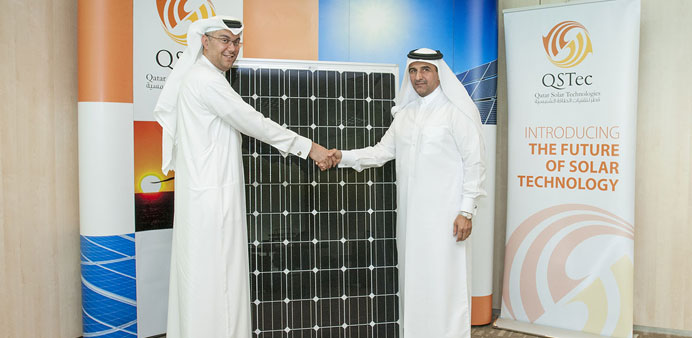|
|
In a landmark development in the country’s pursuit of alternative energy sources, Qatar Solar Technologies (QSTec) yesterday presented Barwa with the first of 136 solar modules that will be used to power Qatar’s Passivhaus-Baytna project.
When installed, the SolarWorld-QSTec photovoltaic monocrystalline silicon panels will provide all of Passivhaus’ electricity requirements, with excess power being exported back into the power grid of Qatar General Water and Power Corporation (Kahramaa).
Dr Khalid K al-Hajri, QSTec chairman and CEO, presented the solar module to Ahmad Abdulla al-Abdulla, Deputy Group CEO of Barwa, in a ceremony at QSTec’s West Bay headquarters. The QSTec-supplied high efficiency panels have an installed power of 34 kilowatt peak and will produce around 58,000 kilowatt hours of electricity per year. Using this solar power system to exclusively supply Barwa’s Passivhaus will help avoid approximately 35 metric tonnes of CO2 emissions per year.
Qatar, with one of the highest solar irradiation rates in the world, has recently announced plans to utilise the sun’s rays as a sustainable energy resource by installing 1.8 gigawatts of solar power over the next few years.
Commenting on his organisation’s plans, Dr Khalid K al -Hajri said: “QSTec aims to bring solar into the mainstream of Qatar’s energy mix. Solar is recognised as Qatar’s primary renewable energy technology and an essential part of our sustainable energy future. Barwa’s Passivhaus-Baytna project will demonstrate that, by using solar and environmental technologies, you can build quality homes and buildings, complete with all the latest modern conveniences, while substantially reducing our carbon footprint and protecting the environment for future generations.”
The Passivhaus-Baytna project is unique for Qatar and the region, where two identical 225 square metre villas are being built side-by-side in Barwa City to compare the energy use and environmental footprint of each dwelling. A regular villa is being constructed to a one-star Global Sustainability Assessment System (GSAS) standard while the Passivhaus villa, with all the comforts of a modern home, will consume 50% less energy and water, resulting in a halving of carbon footprint.
QSTec, Barwa and an array of Qatar’s leading companies and scientific organisations are involved in the Passivhaus initiative. The villas will be ready for occupation later this year.
Families with similar characteristics will be selected to live in each villa, and their energy use compared over time, to showcase the energy savings and impact between the two houses on our environment.
“QSTec and its partners are leading the way in providing high quality solar solutions to Qatar and the region and we are proud to be a part of this ground-breaking project,” Dr al-Hajri added.
With every square kilometre of land in Qatar receiving solar energy equivalent to 1.5mn barrels of crude oil in a year, Qatar is geographically well-positioned to exploit significant solar energy, according to top officials of Qatar Petroleum (QP).
“With an average daily sunshine time exceeding 9.5 hours, low cloud cover conditions and abundant free land space offer a great potential for construction of large-scale solar power plants,” a technical paper jointly presented by Ali Hamed al-Mulla and Pitta Govinda Rao of QP at the second Qatar Japan Environment symposium had said.
Qatar has solar irradiation levels with studies showing an annual rate of 1,858 kWh (kilowatt hour) per square metre/year, they said, adding though considerable seasonal variations exist between summer and winter months, large potential is available throughout the year. During the summer months of May to July, the potential is over 6 kWh per square metre per day, whereas during the winter months (December to February), it is about 3.5 to 4.4 kWh per square metre per day, the paper said.
Qatar Solar Technologies (QSTec) is building a new industry of solar energy in Qatar. QSTec, a joint venture between Qatar Foundation (70%), Solar World AG (29%) and Qatar Development Bank (1%) is building a poly silicon production plant in Ras Laffan Industrial City.
It is being built on a 1.2mn sq km land at a cost of $1bn , estimated to produce 8,000 metric tonnes per year (MTPY) of poly silicon with a design to expand its capacity. Eventually, more than 45,000 MTPY of poly silicon can be produced with the plant being designed seamlessly incorporates ingots, wafers, cells and modules.

